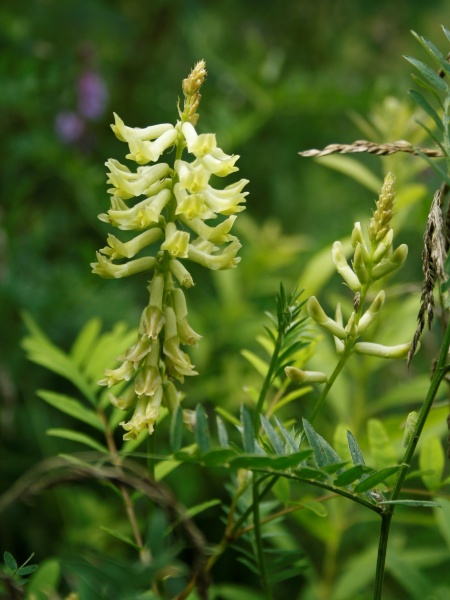 Known to be toxic - Toxic if ingested by livestock.
Known to be toxic - Toxic if ingested by livestock.

Source: Sundaura Alford-Purvis
Astragalus canadensis
Canada Milk-vetch
Astragale du Canada
Synonyms
Canadian milk-vetch
Seeds in stock
Available at table Mixed Sun, Dry
Available at table Mixed Sun, Dry
We currently accept seeds for this plant
Bloom Colour: White
Bloom Period: Jun - Aug
Max Height: 3.0 feet
Max Width: 2.0 feet (spreads by rhizome)
Light Condition:
 More than 6 hours of direct sun a day
More than 6 hours of direct sun a day
 More than 2 or 3 hours but less than 6 hours of direct sun a day
Soil conditions:
More than 2 or 3 hours but less than 6 hours of direct sun a day
Soil conditions:
 Tolerates dry soil condition
Tolerates dry soil condition
 Tolerates medium soil condition
Tolerates medium soil condition
 More than 6 hours of direct sun a day
More than 6 hours of direct sun a day
 More than 2 or 3 hours but less than 6 hours of direct sun a day
More than 2 or 3 hours but less than 6 hours of direct sun a day
 Tolerates dry soil condition
Tolerates dry soil condition
 Tolerates medium soil condition
Tolerates medium soil condition
Lifespan:
Perennial
plants that will that come back year after year
Gardener Experience:
 Suitable for beginner gardeners
Suitable for beginner gardeners
 Does not spread uncontrollably
Does not spread uncontrollably
 Suitable for beginner gardeners
Suitable for beginner gardeners
 Does not spread uncontrollably
Does not spread uncontrollably
Landscape Uses:
 Suitable for container garden
Suitable for container garden
 Suitable for school gardens
Suitable for school gardens
 Suitable for container garden
Suitable for container garden
 Suitable for school gardens
Suitable for school gardens
Ecological Benefits:
 Supports hummingbirds
Supports hummingbirds
 Supports pollinators
Supports pollinators
 Fixes nitrogen in the soil
Fixes nitrogen in the soil
 Supports hummingbirds
Supports hummingbirds
 Supports pollinators
Supports pollinators
 Fixes nitrogen in the soil
Fixes nitrogen in the soil
Tolerates:
 Tolerates limestone conditions
Tolerates limestone conditions
 Tolerates limestone conditions
Tolerates limestone conditions
Special Features and Considerations:
 This plant is septic tank safe
This plant is septic tank safe
 This plant is septic tank safe
This plant is septic tank safe
Plant Location
Native to Ottawa region: Yes
Distribution according to VASCAN

Ephemeral
Native
Introduced
Excluded
Extirpated
Doubtful
Absent
Thrives in Ecozones
- Taiga Plains
- Boreal Plains
- Montane Cordillera
- Prairies
- Mixed Wood Plains
Ecological Benefits
Butterflies Supported by Astragalus canadensis
- Glaucopsyche lygdamus (Silvery Blue)
Specialized Bees Supported by Astragalus canadensis
No bee data available for this plant.
Plants that grow in similar conditions, that bloom at the same time.
Complementary Plants
- Agalinis tenuifolia
Slender-leaved False Foxglove
Gérardie à feuilles ténues - Bouteloua curtipendula
Side-oats Grama
Grand boutelou - Senna hebecarpa
Wild Senna
Casse à fruits velus - Verbena simplex
Narrow-leaved Vervain
Verveine simple - Zizia aurea
Golden Alexanders
Zizia doré
Substitute For Non-Native Plants
- Ajuga reptans (Bugleweed)
- Buddleia (Butterfly Bush)
Sowing Information
Download Seed Envelope Labels (PDF)
- Sowing depth: Sow just below surface
- Sow anytime
- Stratification duration: 10 days
- Notes: Needs scarification if started in fridge.
Harvesting and Seed Sharing
- Harvest start month: August
- Harvesting indicator:
- Pods are brown and slightly open
- Harvesting:
- Open the pod, remove seeds
- Seed viability test:
- No test needed before donating
- Packaging measure: 1 rounded 1/32 teaspoon
- Seed storage:
- Air dry in paper bag or open container, for a few days until crisp
- Shake seeds to move them once in a while to prevent molding
- Cultivar: No, you can donate without knowing the source as there are only straight species
- No harvesting video available at this time.
Toxicity Notes
Toxic if ingested by livestock.


 Canadensis
Canadensis
